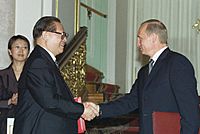2001 Sino-Russian Treaty of Friendship facts for kids
Quick facts for kids 2001 Sino-Russian Treaty of Friendship |
|||||||||||||
|---|---|---|---|---|---|---|---|---|---|---|---|---|---|

Jiang Zemin and Vladimir Putin after signing the FCT
|
|||||||||||||
| Chinese name | |||||||||||||
| Traditional Chinese | 中俄睦鄰友好合作條約 | ||||||||||||
| Simplified Chinese | 中俄睦邻友好合作条约 | ||||||||||||
|
|||||||||||||
| Russian name | |||||||||||||
| Russian | Договор о Добрососедстве Дружбе и Сотрудничестве Между Российской Федерацией и Китайской Народной Республикой | ||||||||||||
The Treaty of Good-Neighborliness and Friendly Cooperation Between the People's Republic of China and the Russian Federation (FCT) is an important agreement between China and Russia. It was signed on July 16, 2001, by their leaders, Jiang Zemin and Vladimir Putin. This treaty set out a plan for the two countries to work together for twenty years. It aimed to build strong, friendly ties between these two big nations.
Contents
What's in the China-Russia Friendship Treaty?
The treaty explains how China and Russia should work together. It focuses on keeping peace and helping each other with money matters. It also covers how they will work together in politics and international talks.
Working Together on Military and Tech
One part of the treaty, Article 9, has caused some talk. Some people think it means if one country goes to war, the other must help. This makes it seem like a defense agreement. Also, Articles A7 and A16 talk about sharing military knowledge and technology. This means China can learn from Russia's military skills and get access to their advanced weapons tech.
Protecting the Environment and Trade
The treaty also talks about working together on other important things. This includes protecting the environment and saving energy. It also covers how they will handle money and trade around the world. The document clearly states that Russia sees Taiwan as a part of China (Article A5). Both countries also promise to protect their own "national unity and territorial integrity" (Article A4). This means they will make sure their countries stay whole and united.
Why Did China and Russia Sign the Treaty?
Experts have found several reasons why China and Russia signed this treaty. Both countries hoped to gain a lot from it.
Benefits for China
- China's military forces needed updates. The treaty helps because Russia agreed to share its training and technology. This helps China make its army stronger.
- China needs a steady and affordable supply of fuel, especially oil. Getting oil from Russia, possibly through a new pipeline, helps China meet this need.
- China wants support for its views on Taiwan. The treaty shows Russia's support for China's position.
Benefits for Russia
- Russia needed money after the Soviet Union broke apart. The treaty helps Russia get more money in several ways.
- Russia wants to find jobs for its skilled workers.
- Russia wants to sell its military technology and knowledge to other countries.
- Russia wants to sell its large amounts of oil and natural gas.
Worries About Other Countries
Both China and Russia were concerned about the United States. They felt the US was getting too involved in areas that China and Russia thought were their own business. For China, this meant the US's relationship with Taiwan. For Russia, it was about the US's ties with countries that used to be part of the Soviet Union.
Competing in the World Economy
The United States, Japan, and the European Union are very strong in the world economy. They have many skilled workers and a lot of money. By working together, Russia and China can better compete against these powerful economies. Russia gets money from China, and China gets training and technology from Russia.
See also
 In Spanish: Tratado de Amistad China-Rusia de 2001 para niños
In Spanish: Tratado de Amistad China-Rusia de 2001 para niños

